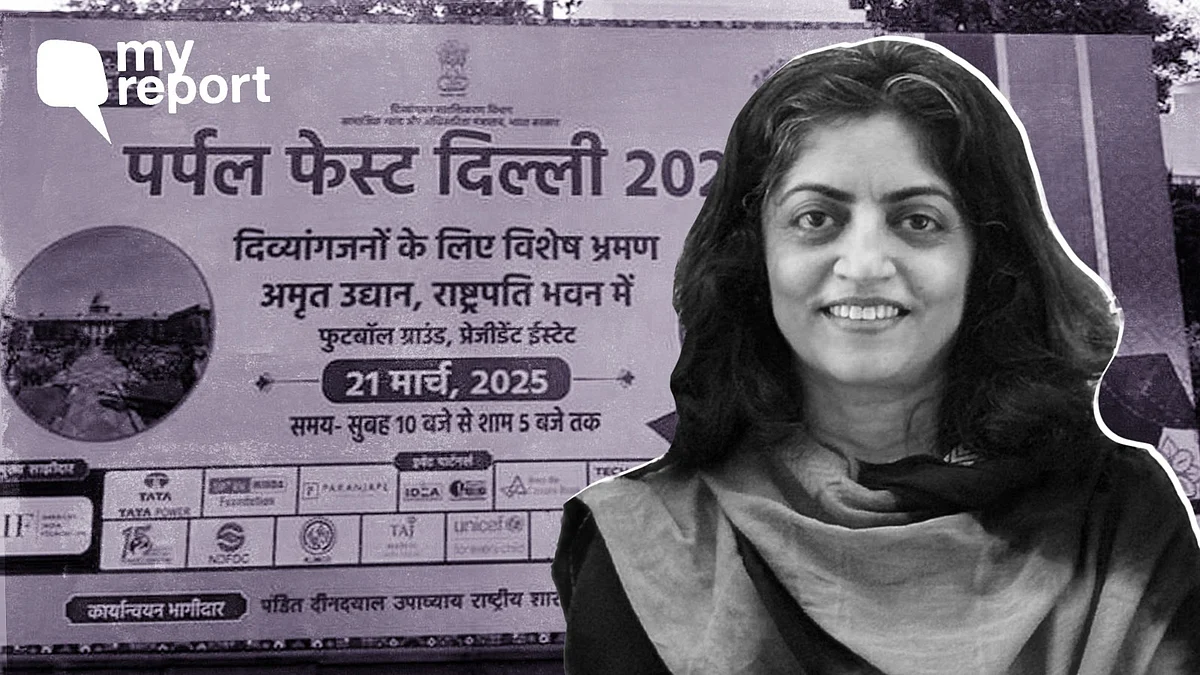
'Ironically, Fest for Disabled at Rashtrapati Bhavan Overlooked Hard of Hearing'
"I rely on captions to access events—just like many in the deaf and hard-of-hearing community."

advertisement
On 21 March, a friend and I attended the Purple Festival at Rashtrapati Bhavan. Organised by the Ministry of Social Justice and Empowerment, Government of India, the 'Purple Fest' aims to raise awareness about disabilities and their impact on people's lives, promoting understanding, acceptance, and inclusion of persons with disabilities in society.
The event was graced by the President of India, Droupadi Murmu. Before the President’s speech, we had the opportunity to explore the various exhibitions and stalls at the festival.
As I wandered through the exhibition halls, I was impressed by the creativity, effort, and passion put into showcasing products, services, and initiatives aimed at supporting persons with disabilities.
I visited a few stalls that showcased products designed for individuals with various disabilities. Some focused on providing tools and services that offered greater independence, while others highlighted innovative products meant to assist with everyday activities.
There was a stall demonstrating tactile maps and braille books, another featuring sensory-friendly environments, and several others presenting solutions that allowed individuals to engage with the world more easily.
What was most striking was the visible effort to create accessible spaces, allowing individuals with disabilities to be more independent and self-sufficient.
It was truly inspiring to see the passion behind these creations and the genuine desire to make life easier for everyone, regardless of physical or sensory challenges.
'Without Captions, The Fest Was Inaccessible To us'
However, as I moved from stall to stall, there was one glaring issue that I couldn’t ignore: the lack of captions. While the booths offered a variety of engaging and informative displays, including video demonstrations and presentations, there was no captioning available.
Whether it was a video on how a product worked or a staff member explaining a service, there was no way for me to fully engage with the content.
After exploring the exhibitions, we barely made it in time for the President’s speech. I squeezed into a spot up front, ready for my usual mix of listening, lipreading, and mostly reading captions that transcribe speech to text on a screen—only to find there were none.
When I inquired about accessibility, I was told that a sign language interpreter was available—but that’s not the kind of access I need.
We reached out to the organisers and staff for help, but they refused to listen and even shoved us aside, prioritising wheelchair users.
This experience highlighted the widespread ignorance about invisible disabilities, especially the lack of awareness regarding the spectrum of deafness—most of whom are non-signers. With no captions available, we had no choice but to leave disappointed.
As someone with hearing loss, I often rely on captions to fully access events. This is a need shared by many in the deaf and hard-of-hearing community.
'Small Adjustments Can Make A Big Difference'
In India, there is progress. Some Disabled People’s Organisations (DPOs) have begun incorporating captions along with sign language interpreters, often using automated tools with steadily improving technology.
These efforts are part of a larger push to make events truly inclusive. Sadly, the Purple Festival did not reflect this progress, and it served as a stark reminder of how far we still need to go.
The experience at the Purple Festival left me reflecting on how accessibility should go beyond just offering physical access to spaces and services. True inclusion encompasses all forms of access, including access to information, communication, and participation.
While I appreciated the efforts of the organisers and the numerous exhibitors, the lack of attention to captioning underscored a gap that still needs to be addressed.
'Technology Can Help Make Events Like These More Accessible For Us'
I understand that implementing captions can be challenging at times, but with the advancements in technology, it is not an insurmountable task.
The Purple Festival was a step in the right direction, but it also served as a reminder of how much more needs to be done. Accessibility is not a one-size-fits-all solution.
It requires a multifaceted approach that considers the diverse needs of individuals. In a country as diverse as India, with its myriad of languages, disabilities, and unique challenges, ensuring true inclusion means listening to the voices of those who are often left unheard.
(The Quint has reached out to the Union Ministry of Social Justice and Empowerment on the issue. Their response is awaited. The story will be updated as and when they respond.)
(All 'My Report' branded stories are submitted by citizen journalists to The Quint. Though The Quint inquires into the claims/allegations from all parties before publishing, the report and the views expressed above are the citizen journalist's own. The Quint neither endorses nor is responsible for the same.)
- Access to all paywalled content on site
- Ad-free experience across The Quint
- Early previews of our Special Projects
Published: undefined